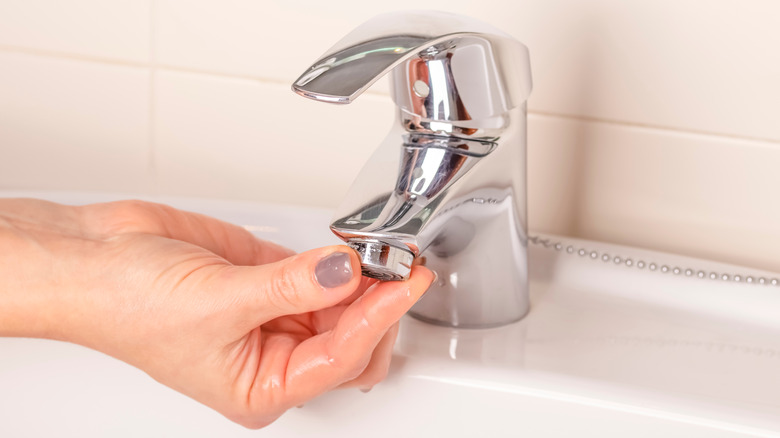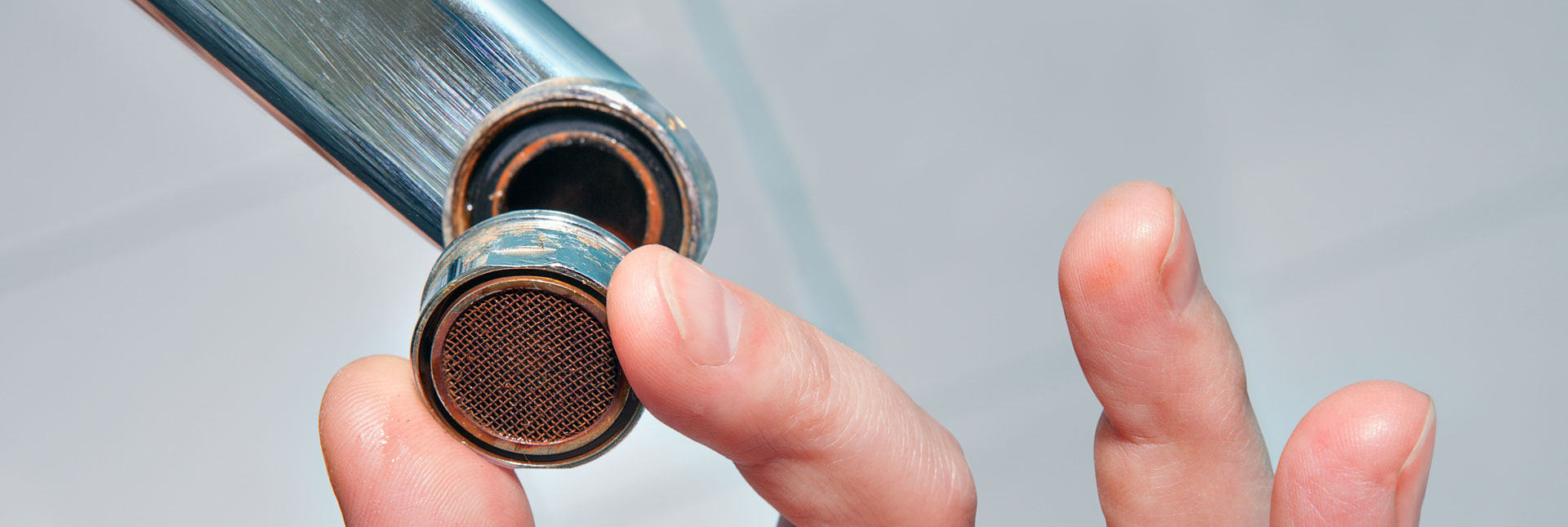Bathtub faucet aerators are a great way to prevent water from splashing out. The problem is that they can be difficult to find and not all bathtub spouts have them. This article will tell you how to check if your tub faucet has an aerator and what you need to know about taking care of your bathtub aerator.
- What Are Faucet Aerators?
- What Is The Purpose of a Faucet Aerator?
- Do bathtub faucets have aerators?
- Do you need an aerator on a faucet?
- How to check if your bathtub faucet has an aerator
- Are Faucet Aerators Universal?
- How to Replace a Bathroom Faucet Aerator
- How Much Water Does a Faucet Aerator Save?
- How do you clean a bathtub faucet aerator?
- How to Perform a Proper Aerator Maintenance
What Are Faucet Aerators?
If you’ve ever noticed your water pressure seems a bit low, or that your sink sprays water all over the place, it might be time to install a faucet aerator. Faucet aerators are small attachments that go on the end of your faucet and help spread the water out more evenly. This not only makes it feel softer and prevents splash-back, but it also helps conserve water by using less force to get the job done.
They’re especially beneficial in areas with hard water, as mineral deposits can build up inside the pipes and clog them over time. By regularly cleaning your aerator, you can help keep things flowing smoothly and prevent any nasty surprises down the road!
Aerators come in all shapes and sizes, so make sure to get one that’s compatible with your faucet type (the standard size is 0.5 inches). You can usually find them for sale at home improvement stores or online for around $10.
What Is The Purpose of a Faucet Aerator?
A faucet aerator is a device that screws onto the end of a faucet and mixes air with the water coming out of the faucet. This makes the water come out in a more gentle stream and it also helps to save water. Aerators are colour-coded, so you can tell how much water flow you are getting from your aerator. There are three different colours: red, green, and blue.
The red aerator has the least amount of water flow, while the blue aerator has the most amount of water flow. If you don’t need as much water pressure, then you can use a red or green aerator. However, if you need more water pressure for things like cleaning dishes or filling up a bathtub, then you would remove the flow restrictor on the blue aerator to get more water pressure. Removing the flow restrictor increases water pressure and bills because of a higher flow rate.
By adding small bubbles to the water, the faucet aerator lets the faucet run longer while using less water.
- Makes the water flow wider.
- fewer splashes of water in the basin
- Saves water by making the water flow more efficiently.
- When a flow-stopping aerator is added, it can also save water.
- Soap works faster with bubbles, saving both soap and water.
- Makes the water feel smoother when you touch it.
- Gives water a lighter, more refreshing taste.
- Filters sediment

Do bathtub faucets have aerators?
Yes, most bathtub faucets have aerators. It’s easy to tell if your bathtub faucet has an aerator. Most spouts have them, in order to keep water from splashing out of the tub. Faucet aerators are screens which add air to the water as it streams out of the faucet. They screw into kitchen and bathroom faucets and help reduce the amount of water that comes out, control the stream, and increase efficiency.
If you’re not sure whether or not your bathtub faucet has an aerator, just take a look at it! It’ll be pretty obvious – most spouts have them installed by default in order to conserve resources. Plus, they make baths more comfortable because they limit how much water sprays out all at once.
Do you need an aerator on a faucet?
If you’re not sure whether or not you need an aerator on your faucet, ask yourself the following questions: “Do I have a problem with water splashing?” and “Do I feel like my water pressure is low?” If you answer yes to either of these questions, then it’s likely that you could benefit from installing an aerator.
Aerators are small screens placed on the end of faucets which break up the flow of water into multiple streams. This creates a sense of clarity, adding air in between water streams for an increased feeling of refreshment and better odor control. Aerators also reduce the volume of water flowing from a faucet, which means less water usage. And lastly, aerators are environmentally friendly and save a lot of money. So if you’re looking for ways to be more eco-friendly or want to start saving money on your monthly utility bills, installing a new faucet aerator may be just what you need!
There are three main styles of aerators: aerated, spray and laminar. Standard “standard” aerator is 2.2 GPM while a mesh screen aerator only uses 1.0 gallons per minute. Mesh screen aerators allow the user to feel like they are being used normal water pressure even though less water is actually flowing from the tap. Faucet aerators reduce hot water consumption and help to consume less energy.
How to check if your bathtub faucet has an aerator
If you’re curious to know if your bathtub faucet has an aerator, don’t worry. It’s easy to find out.
An aerator is a small mesh screen that is placed on the end of a faucet. It adds air in between streams of water, which makes the water come out slower and feel more forceful. Aerators are important because they improve the physical operation and enhance the experience of using a faucet.
Aerators are becoming more and more popular in homes as they help reduce water waste. By installing an aerator on your bathtub faucet, you can reduce the volume of water flowing from the faucet while still maintaining the feeling of a high-pressure flow. In addition, sink splashing is reduced by aerators, making them a great option for kitchens and bathrooms.

Are Faucet Aerators Universal?
Are faucet aerators universal? That is a question that many people ask. The answer, unfortunately, is no. Faucet aerators come in different sizes and are designed for specific purposes. There are three basic types of faucet aerators: standard, junior, and Tom Thumb.
Standard-sized faucet aerators are a quarter-inch in size and fit the most common faucets. Junior-sized faucet aerators are similar in size to nickel and fit smaller faucets such as those found on bathroom sinks. Tom Thumb-sized faucet aerators are the size of a dime and fit the smallest of taps, such as those often found on kitchen sinks.
The size of the faucet aerator is determined by the coin it is designed to fit. If you have a fourth coin that fits your Aerator snugly, then you will need only one standard-sized Aerator. However, if your Aerator is the same size as a nickel, you will need a junior-size Aerator; and if it’s similar in size to a penny, you’ll need a tiny Tom Thumb-size Aerator.
How to Replace a Bathroom Faucet Aerator
If you’re looking for a quick and easy way to improve your bathroom faucet, consider replacing the aerator. A towel and a pair of pliers are all you need to replace or put in a new faucet aerator. The best kind of pliers for this project are tongue and groove pliers, like Channellock. The towel should be small because it will be used as a shield when you use the pliers on the faucet aerator.

- Clean the inside thread of the faucet with the towel.
- Make sure the aerator is all put together. To stop leaks, the washer must be in place on the aerator of a faucet.
- Put the aerator in the faucet’s end until the threads catch.
- Screw the aerator into the faucet by hand by turning it clockwise.
- Use the wrench to tighten the towel around the faucet’s aerator.
- To test, turn the water on all the way.
- If you tighten the aerator too much, you could strip the threads on either the faucet or the aerator.
How Much Water Does a Faucet Aerator Save?
A faucet aerator is a device that screws onto the end of your faucet and helps to reduce water flow. While it may seem like a small change, installing an aerator can save you up to 30% of your daily water usage. That’s because, without an aerator, most taps flow at 2.5 gallons per minute (GPM). With an aerator, that rate is reduced to 1.5-2 GPM. For a family of four, that could mean saving more than 100 gallons of water each day!
Not only does using a faucet aerator help conserve our valuable resources, but it also has other benefits as well. Aerators introduce oxygen into the water flow which helps prevent corrosion from lime build-up on pipes and can even improve the taste of your tap water. And if you’re ever thinking about replacing your bathtub spout, make sure to check first to see if it already has an aerator installed – 95% of homes do!
How do you clean a bathtub faucet aerator?
If you’re noticing a change in water pressure, it might be time to clean your bathtub faucet aerator. This is a simple process that can be done at home with a few household items.
- First, gather some supplies. You’ll need vinegar, warm water, dish soap, a toothbrush (or old toothbrush), and a rag.
- Next, locate the aerator on your faucet. It’s usually located near the spout and is easy to spot because it has small holes or slots in it. If you can’t remove the aerator by hand, soak it in vinegar for one hour before cleaning.
- Once you have the aerator removed, use a rag and vinegar to clean off any mineral deposits inside of the spout. Be sure to get into all of the nooks and crannies! Use an old toothbrush if needed.
- Rinse off any excess vinegar and reassemble the aerator before installing it back onto the faucet.
How to Perform a Proper Aerator Maintenance
Maintaining your faucet aerator is an easy task that can be completed in a few minutes. All you need is a wrench and a little bit of time.
First, use the wrench to remove the aerator from the faucet. This will make it easy to clean them with some hot water and soap. Once they’re clean, make sure to let them air dry before replacing them on the faucet.
If you’re looking to buy a new aerator for your bathroom faucet, make sure it’s made by a company that is certified by the WaterSense program. This certification means that the aerator has been tested and meets strict performance standards set by EPA.
When checking if your bathtub faucet has an aerator, keep in mind that it should be performing at 1.5 gallons per minute or less. Anything higher than this could mean you need to clean or replace your aerator
Also Read:
Mike Spencer
Hi Guys, Mike is a Mechanical Engineer who specializes in Heating, Ventilation, and Air-conditioning. His love for humanity and his profession propels him to share useful and factual Information on this blog.
